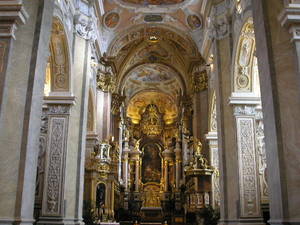Klosterneuburg Monastery

According to the legend, the monastery of Klosterneuburg was built right in the place where after nine years Margrave Leopold III found the veil of his wife Agnes on top of an elderbush.
The foundation of the monastery dates back to 1114, in 1136 the church of the monastery was consecrated. Soon after, on Nov. 15th, 1136, Leopold III died in a hunting accident. In 1485 he was sainted, and in 1663 he was appointed patron of Austria by his namesake, Emperor Leopold I.
The baroque reshaping started in the middle of the 1630ies. In the 18th century the whole site was thoroughly reconstructed, partly according to the plans of Jakob Prandtauer, the famous master builder of Melk. Charles VI, the father of Empress Maria Theresia wanted to expand the monastery to an Austrian Escorial, but after his death the project scattered. It was not until 1842 that architect Josef Kornhäusel completed around a quarter of the original construction plans: one courtyard, and the two conspicuous cupolas with the Roman imperial crown and the Austrian archducal hat on top. In the 1880ies, the Austrian architect Friedrich Schmidt reconstructed the towers of the abbey in neogothic style.
In the very beginning, the monastery was a secular canon monastery, not obliged to any monastic rule. The first provost was Otto of Freising, son of Leopold III, and an important medieval chronicler. The original intention of the margrave to build a cathedral in the place of his residency failed.
The Augustinian Canons called by Leopold III came to Klosterneuburg in 1133 and over the centuries expanded the monastery to a religious, cultural and scientific center. Distinct from monks, the Augustinian Canons’ major mission is the pastoral care. Currently, canons from Klosterneuburg are in charge of 24 parishes in Lower Austria and Vienna.
The monastery also plays an important role in wine growing. The vineyard of Klosterneuburg Monastery with over 104 hectars counts among the oldest wine growing estates in Austria, dating back to Leopold III. As early as 1860 the monastery supported the founding of a school for viticulture, which later developed into todays Federal Institute for Viticulture and Pomology.
The Monastery Museum, founded in the 18th century, is famous for its medieval art collection. Among its most valuable exhibits count the Babenberger family tree of the 15th century and works of the renaissance painter Rueland Frueauf the Younger (1470-1547), e.g. four panel paintings with scenes from the „Veil Legend“.
The Verdun Altar, completed in 1181, is one of the most valuable possessions of the monastery. From a technical as well as from an artistic point of view, it is one of the most impressive medieval goldsmith works, consisting of 51 panels in 3 rows showing scenes of the Old and the New Testament.
Source:
http://www.stift-klosterneuburg.at/; http://de.wikipedia.org/wiki/Stift_Klosterneuburg
Image source:
http://commons.wikimedia.org/wiki/File%3AStift_Klosterneuburg_2007_007.jpg





